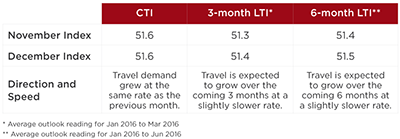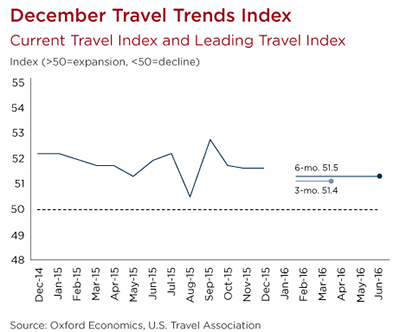U.S. Travel’s New Economic Indicator Is Signature Measurement of $2.1 Trillion Industry’s Performance in Broader U.S. Economy
WASHINGTON (February 2, 2016)—The U.S. Travel Association on Tuesday released its inaugural Travel Trends Index (TTI), a two-prong indicator developed by the organization’s economic research team to both track and predict the volume and pace of travel to and within the U.S. The TTI will be released on the first Tuesday of each month.
This month’s TTI—which measures travel trends as of December 2015—shows that travel growth leveled off at the end of the year and forecasts moderate growth in early 2016.
Domestic leisure travel continues to strengthen, thanks to rising wages and low gas prices.
Business travel, by contrast, contracted due to volatile markets and rising interest rates, although the TTI predicts a slight recovery for that segment in the first half of 2016.
Inbound international travel, while still on a slight growth trajectory, has leveled off considerably due to the strong U.S. dollar.
The TTI assigns a numeric score to every travel segment it examines—domestic and international, leisure and business—in current, 3-month predictive and 6-month predictive indicators. As with many indices similarly measuring industry performance, a score above 50 indicates growth, and a score below indicates contraction.
“The clear picture that the TTI provides of the economic trajectory of travel will enable both federal policymakers and members of our industry to make informed decisions,” said U.S. Travel Association President and CEO Roger Dow. “The indispensability of travel and tourism to the broader economy has been evident for some time, but now we have the definitive resource for measuring both its recent and future performance. The TTI is a powerful tool, and further cements travel’s place as a leading U.S. industry.”
The TTI draws from multiple data sources to develop a monthly reading of both international inbound and domestic business and leisure travel numbers, and predict the likely average pace and direction of these travelers over upcoming three and six month periods.
The TTI consists of the Current Travel Index (CTI), which measures the number of person trips involving hotel stays and/or flights each month, and the Leading Travel Index (LTI), which measures the likely average pace and direction of business and leisure travel, both domestic and international inbound.
The U.S. Travel Association developed the TTI in partnership with Oxford Economics. In order to compile both the CTI and LTI readings, the organization’s research team draws from multiple unique, non-personally identifiable data sets, including:
- Advance search and bookings data from ADARA and nSight;
- Passenger enplanement data from Airlines for America (A4A);
- Airline bookings data from the Airlines Reporting Corporation (ARC); and
- Hotel room demand data from STR.
Learn more about the Travel Trends Index.
Click here to read the full report.



